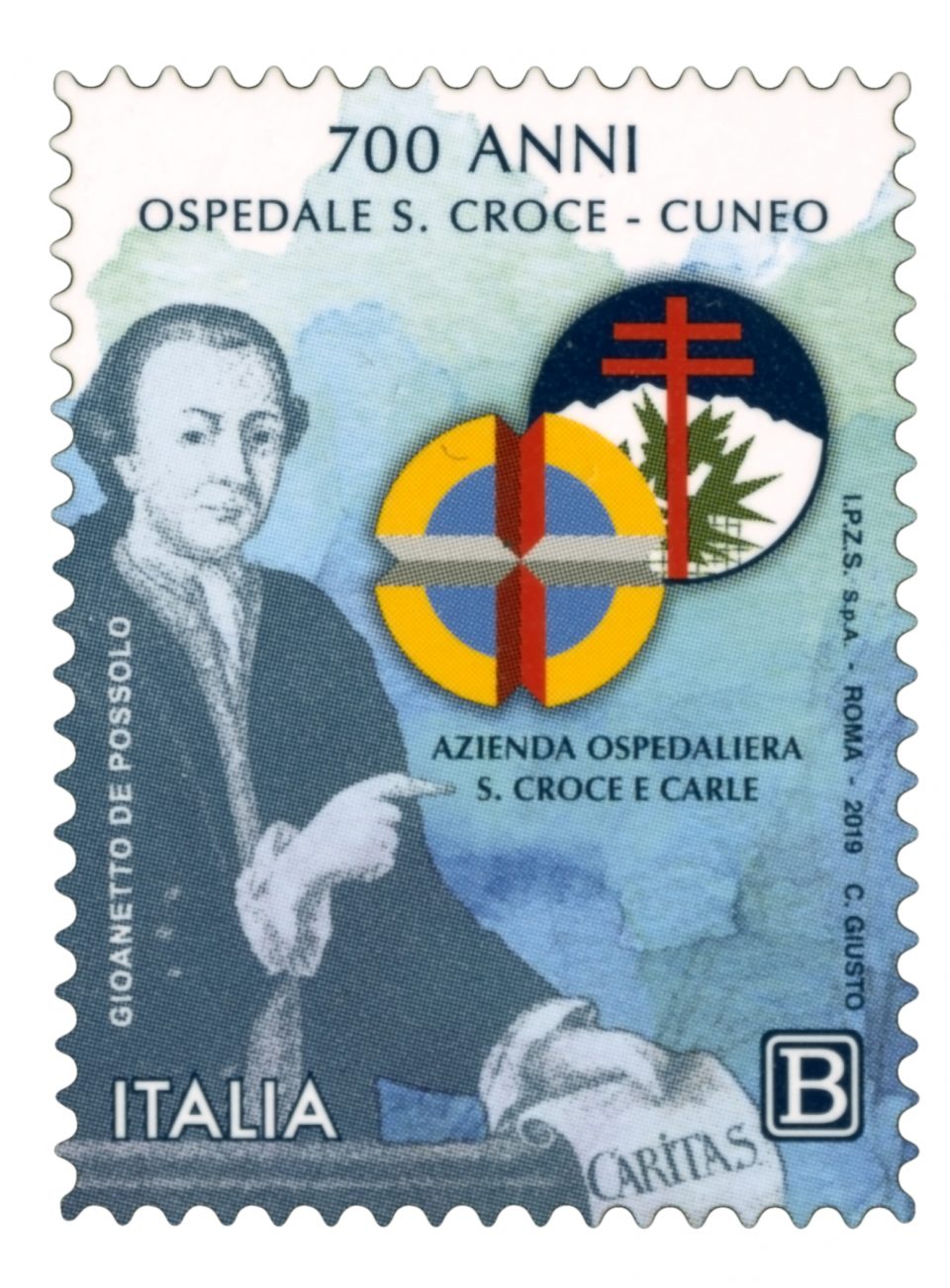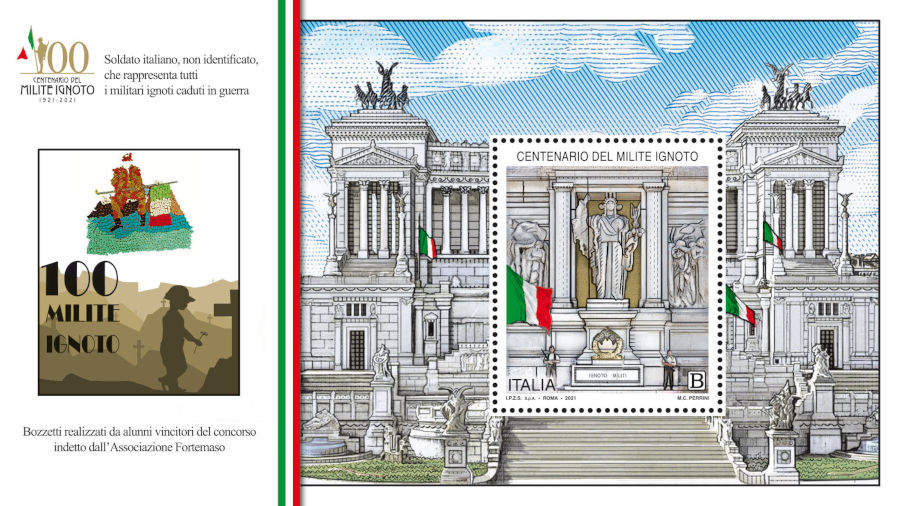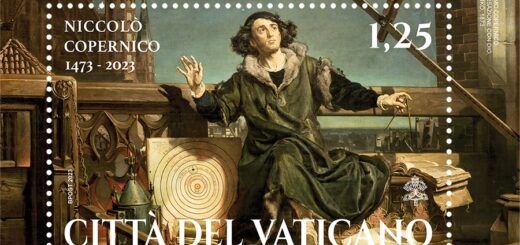POSTE ITALIANE 24^ emissione anno 2019 del 18 Maggio di un francobollo dedicato ordinario appartenente alla serie tematica “le Eccellenze del sapere” dedicato all’Ospedale S. Croce e Carle di Cuneo, nel VII centenario della fondazione.
POSTE ITALIANE 24^ emissione anno 2019 del 18 Maggio di un francobollo dedicato ordinario appartenente alla serie tematica “le Eccellenze del sapere” dedicato all’Ospedale S. Croce e Carle di Cuneo, nel VII centenario della fondazione.

Il Ministero dello Sviluppo Economico ha emesso il 18 maggio 2019 un francobollo ordinario appartenente alla serie tematica “le Eccellenze del sapere” dedicato all’Ospedale S. Croce e Carle di Cuneo, nel VII centenario della fondazione, relativo al valore della tariffa B, corrispondente ad €1.10.
- data / date 18 maggio 2019
- dentellatura / serration 11
- stampa / printing fustellatura/rotocalco
- tipo di carta / paper type bianca patinata neutra
- stampato / printed I.P.Z.S. Roma
- tiratura / edition 2.500.000
- fogli / sheet 45
- dimensioni / dimension 30 x 40 mm
- costo / price B = € 1,10
- bozzettista/ designer C. Giusto
- num. catalogo/catalog num. Michel 4121 YT 3882 UN 3964
L’Ospedale S. Croce da 700 anni è “l’Ospedale” della città di Cuneo, oltre che la principale struttura ospedaliera della provincia e, per alcune specialità, punto di riferimento anche per persone che arrivano da fuori provincia e fuori regione. Per 700 anni ininterrotti l’ospedale è stato parte della storia di tante persone, garantendo assistenza e cure sempre più specialistiche”. L’ Ospedale fondato da Gioanetto de Possolo che il 18 maggio 1319, consentì l’avvio di un percorso che, nei secoli, portò alla realizzazione di un ospedale di eccellenza di livello nazionale.
L’ospedale S. Croce: da ricovero medioevale a moderno ospedale”, è e sarà sempre stimato per i rapporti tra l’Ospedale, la Città e i Cuneesi e un legame molto forte mai venuto meno nei secoli.
Importante e limitrofo all’Ospedale insiste la Chiesa di Santa Croce, appartenente alla Confraternita di Santa Croce è presente a Cuneo fin dal XIV secolo. I confratelli si riunivano per le celebrazioni e per prestare il proprio servizio nell’assistenza di ammalati e bisognosi; essi indossavano un saio bianco con cappuccio, per nascondere il volto e non dare spazio a ostentazioni. A partire dal Cinquecento si insediarono nel quartiere di San Francesco, dove sorgeva l’importante convento dei Francescani: all’interno di questa chiesa, i confratelli possedevano una cappella che avevano fatto affrescare da Pietro Pocapaglia da Saluzzo nel 1482 e che conserva ancora oggi la decorazione originaria. Anche la confraternita di Santa Croce aveva un proprio oratorio e naturalmente l’ospedale, che era cresciuto nel corso del tempo; la struttura poteva ospitare fino a una cinquantina di persone, per un’attività sanitaria basata allora più sull’assistenza e sul ricovero che sulle cure vere e proprie. Nel dicembre 2017, dopo un lungo periodo di chiusura, la chiesa di Santa Croce viene riaperta al pubblico, restaurata e messa in sicurezza.
All’inizio del Settecento la chiesa venne completamente rinnovata: il progetto fu affidato al torinese Antonio Bertòla. Il cantiere, avviato nel 1709, fu condotto dall’architetto Francesco Gallo che apportò alcune modifiche all’idea del maestro, soprattutto in facciata; nel 1715 la chiesa risultava già terminata e si poteva procedere alle celebrazioni. Il corpo dell’edificio è collocato trasversalmente rispetto all’isolato, con un andamento concavo che crea un piccolo sagrato, particolarmente d’effetto per chi arriva dalle anguste contrade del centro storico. La chiesa è incastonata all’interno del grande complesso dell’ospedale di Santa Croce: costruito a più riprese tra 1732 e 1876, esso ha servito la città fino agli anni Sessanta, quando i servizi sono stati trasferiti nella sede attuale, nella zona della stazione ferroviaria. Oggi l’edificio è destinato a diventare sede della biblioteca civica e ospita già la sezione dedicata a bambini e ragazzi.
La pianta della chiesa si compone di due ellissi, raccordate dall’area del presbiterio, una per il coro, l’altra, per l’assemblea, ulteriormente movimentata dalle cappelle laterali. Alla decorazione interna, conservatasi straordinariamente in modo organico, lavorarono i principali artisti del periodo: al quadraturista Pietro Antonio Pozzi si devono le finte architetture dipinte nelle cappelle laterali, il luganese Domenico Beltramelli realizzò gli eleganti stucchi con elementi floreali, puttini e angeli, il pittore Francesco Gaggini affrescò entro le cornici le figure delle Virtù, dei Profeti, dei dottori della Chiesa e degli Evangelisti. Lungo il perimetro dell’aula sono collocati i quattordici teleri (provenienti dalla vecchia chiesa) dipinti nel 1626 da Giulio e Giovanni Battista Bruno per le famiglie nobili affiliate al sodalizio e raffiguranti i Miracoli della croce. Tra gli arredi della chiesa è di particolare pregio il gruppo processionale con il Cristo porta croce attribuito a Giuseppe Maria e Stefano Maria Clemente e databile a metà Settecento.
Se sei interessato all’acquisto del francobollo lo puoi acquistare al prezzo di € 1.50. Inviami una richiesta alla email: protofilia1@gmail.com
POSTE ITALIANE 24th edition of the year 2019 of May 18th of a dedicated ordinary stamp belonging to the thematic series “Excellence in knowledge” dedicated to the S. Croce and Carle Hospital of Cuneo, on the VII centenary of the foundation.

On May 18, 2019, the Ministry of Economic Development issued an ordinary stamp belonging to the thematic series “Excellencies of knowledge” dedicated to the S. Croce and Carle Hospital of Cuneo, on the VII centenary of the foundation, relating to the value of tariff B, corresponding for € 1.10.
For 700 years, the S. Croce Hospital has been the “Hospital” of the city of Cuneo, as well as the main hospital of the province and, for some specialties, a reference point also for people arriving from outside the province and outside the region. For 700 uninterrupted years the hospital has been part of the history of many people, guaranteeing increasingly specialized assistance and care “. The Hospital founded by Gioanetto de Possolo that on May 18, 1319, allowed the start of a path that, over the centuries, led to the creation of a national excellence hospital.
The S. Croce hospital: from medieval shelter to modern hospital “, is and will always be estimated for the relationships between the Hospital, the City and the Cuneesi and a very strong bond never failed over the centuries.
Important and adjacent to the Hospital insists the Church of Santa Croce, belonging to the Confraternity of Santa Croce, is present in Cuneo since the 14th century. The confreres met for celebrations and to provide their services in the assistance of the sick and needy; they wore a white hooded tunic to hide their faces and make no room for ostentation. From the sixteenth century they settled in the district of San Francesco, where the important Franciscan convent once stood: inside this church, the brothers had a chapel that they had frescoed by Pietro Pocapaglia from Saluzzo in 1482 and which still preserves the original decoration. Even the confraternity of Santa Croce had its own oratory and of course the hospital, which had grown over time; the structure could accommodate up to fifty people, for a health activity based then more on assistance and hospitalization than on real care. In December 2017, after a long period of closure, the church of Santa Croce is reopened to the public, restored and made safe.
At the beginning of the eighteenth century the church was completely renovated: the project was entrusted to the Turin Antonio Bertòla. The construction site, started in 1709, was led by the architect Francesco Gallo who made some changes to the master’s idea, especially on the façade; in 1715 the church was already finished and celebrations could be held. The body of the building is placed transversely to the block, with a concave shape that creates a small churchyard, particularly effective for those arriving from the narrow districts of the historic center. The church is set inside the large complex of the Santa Croce hospital: built several times between 1732 and 1876, it served the city until the 1960s, when services were transferred to its current location in the station area train. Today the building is destined to become the seat of the civic library and already houses the section dedicated to children and young people.
The plan of the church consists of two ellipses, connected by the area of the presbytery, one for the choir, the other for the assembly, further enlivened by the side chapels. The main artists of the period worked on the interior decoration, which has been preserved extraordinarily in an organic way: the fake architectures painted in the side chapels owed to the quadraturist Pietro Antonio Pozzi; Francesco Gaggini frescoed the figures of the Virtues, the Prophets, the Doctors of the Church and the Evangelists within the frames. Along the perimeter of the classroom are the fourteen canvases (from the old church) painted in 1626 by Giulio and Giovanni Battista Bruno for the noble families affiliated to the association and depicting the Miracles of the cross. Among the furnishings of the church, the processional group is particularly valuable with the Christ carrying the cross attributed to Giuseppe Maria and Stefano Maria Clemente and dating back to the mid-eighteenth century.
If you are interested in buying the stamp you can buy it for € 1.50. Send me a request to the email: protofilia1@gmail.com

- data / date 18 maggio 2019
- dentellatura / serration 11
- stampa / printing fustellatura/rotocalco
- tipo di carta / paper type bianca patinata neutra
- stampato / printed I.P.Z.S. Roma
- tiratura / edition 2.500.000
- fogli / sheet 45
- dimensioni / dimension 30 x 40 mm
- costo / price B = € 1,10
- bozzettista/ designer C. Giusto
- num. catalogo/catalog num. Michel 4121 YT 3882 UN 3964






